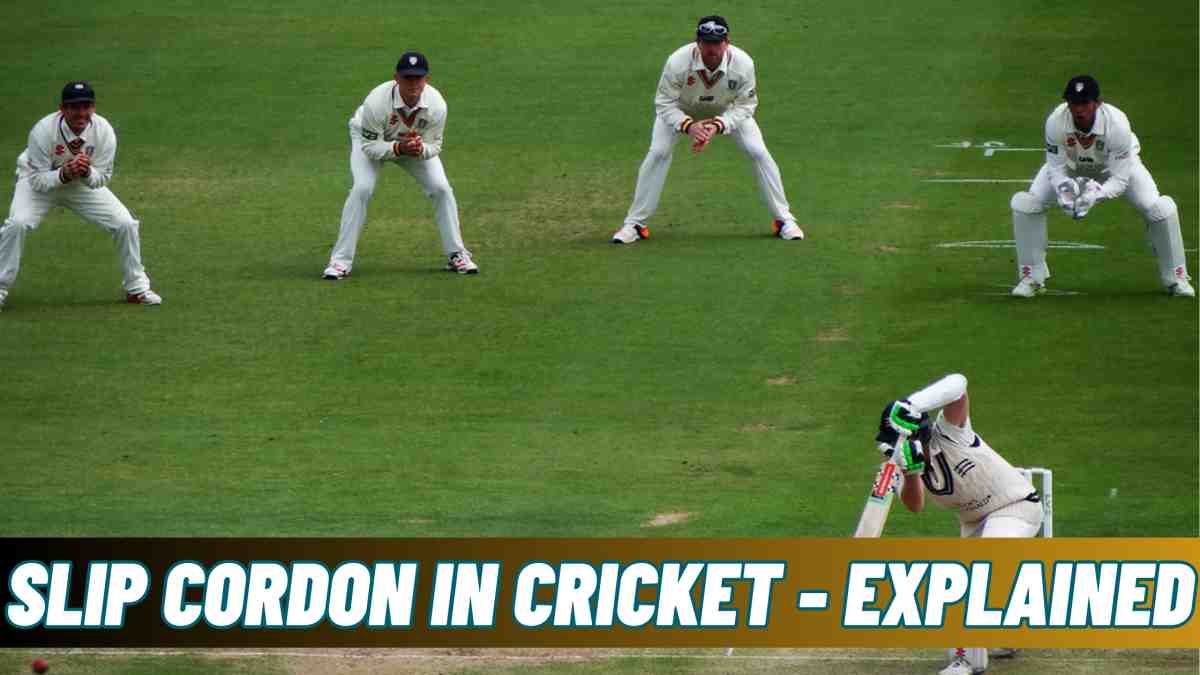
We all know that cricket is one of the most viewed and followed sports in the world. The gentleman’s game is rapidly spreading across the globe, indicating that the sport is reaching more people and providing more exposure to other countries that are just getting started.
While the game itself is not difficult to grasp, there are many underlying technical phrases that make it challenging for newcomers to the sport at times, particularly in fielding positions.
With that in mind, we’ll be discussing fielding positions here over time. And today we’ll begin with one of the most common and fundamental positions of all: the slips.
What is Slip Cordon?
A cordon is when all players field in the slips; it is also known as a slip cordon. This occurs when a slip fielder is assigned to the off side of the field behind the batter.
The purpose of putting a slip fielder on the off side is to ensure that the player catches an edged ball that is beyond the reach of the wicketkeeper.
Why is it Called a Slip?
A slip is a fielder who is placed beside the keeper at a specific angle. The word gained popularity after several captains realised that having a wicketkeeper behind the stumps was not a foolproof strategy, as he could not cover the entire length of the pitch by himself.
Also, it was discovered that the keepers were responsible for fumbling the ball; therefore, the captains decided it would be preferable to deploy a couple of fielders there to avoid any ‘slip’ up by the keeper. As a result, the word slip was coined.
Also Read | The Ten Greatest Fielders of All Time in Cricket
Types of Slips in Cricket
Slips: These fielders stand to the left or right of the wicketkeeper, depending on which hand the batter uses. The number of slips might range from 1 to 5.
They stand in a staggered diagonal line to avoid diving in each other’s way, and their positions will fluctuate according to the bowler’s speed. They are there to stop runs, but their primary goal is to catch the edged balls.
Gully and Leg Gully: Gully appears to be a fourth slip, but the fielder is much deeper and squarer than the slip cordon. The gully’s duty is to prevent batters from cutting away shots to the boundary on the back foot and to grab balls that the slips would otherwise miss. The purpose of the leg gully is identical but on the opposite side.
Leg Slip: This fielder, unlike the other slip catchers, stands on the other side of the wicketkeeper. They are there to take any nicks or draw shots that the batter unintentionally plays down past their leg side rather than to the off side.
This is a useful fielding position that frequently takes some batters off guard. However, it is frequently limited since only 2 fielders can be placed beyond the square (horizontally from the batter’s crease) on the leg side.
Also Read | The Difference Between Off Side and Leg Side in Cricket
Importance of Slip Catching
A slip fielder is often located behind the batsman on the other side of the field. Leg slips are also common these days, especially when spinners bowl.
Slip fielders are often situated with the goal of collecting an edged or glanced ball that is beyond the reach of the wicketkeeper. Slip fielding is a specialised skill, and not every strong outfielder develops it.
A slip fielder must focus intently on each and every delivery of the game. After standing in the slips for the entire day, they may have 3-4 deliveries come their way; this can be intimidating during Test matches and First-Class matches, as the fielders will most likely be there throughout the day in the slips.
A day consists of around 90 overs bowled, or 540 deliveries, with approximately 3-4 deliveries coming to the slip fielders. As a result, the main obstacle for slip fielders is being concentrated all the time, as it is quite easy for them to lose concentration considering how few deliveries come their way.
‘There are no simple catches in the slips,’ observed Rahul Dravid, who holds the record for most Test catches and is perhaps India’s best slip fielder. This phrase is true since most of the time, whether for a quick bowler or a spinner, a player has little time to respond in the slips.
Every team must find players with the mentality and reflexes to excel in the slips. Slip fielders are significantly more vital in test matches because most new ball wickets are taken in the slips. Many catches in the subcontinent are taken at Slip or Leg Slip when the spinners work in tandem.
Another famous slip fielder, Mark Waugh, once stated, “Don’t try to catch the ball; let the ball catch you.” This requires exceptionally soft palms, which help to absorb the stress of the ball on impact and considerably reduce the likelihood of the ball being dropped. With this method, Waugh made even the most difficult catches at slip, whether from a quick bowler or a spinner, look easy.
Slip Fielding Techniques
There are two techniques for fielding at slip for fast bowlers: one is to look at the ball, and the other is to look at the edge of the ball. Both need a great deal of concentration and patience.
When fielding at slip for spinners, on the other hand, it is vital to read the bowler’s hand to understand which direction the ball will turn; this will help to anticipate where the ball will go after taking the edge of the bat.



Comments (1)
Gully Fielding in Cricket - Explainedsays:
November 19, 2023 at 6:33 am[…] similar to slip, is an off-side attacking fielding position situated behind the wicket. The gully fielder has a […]